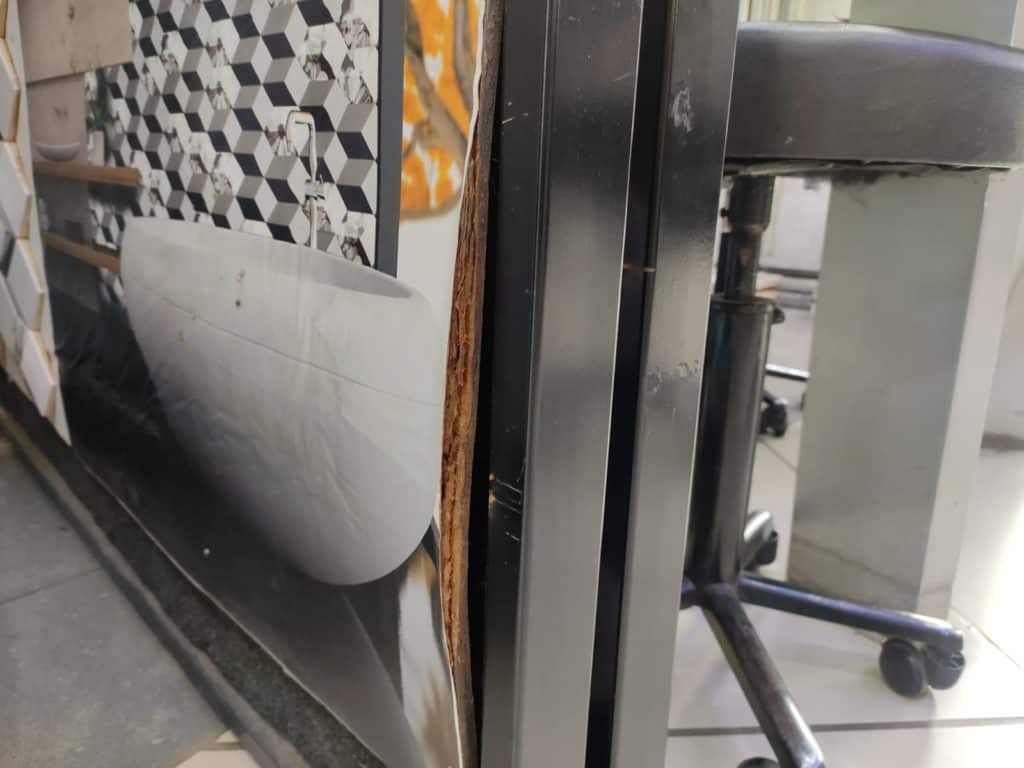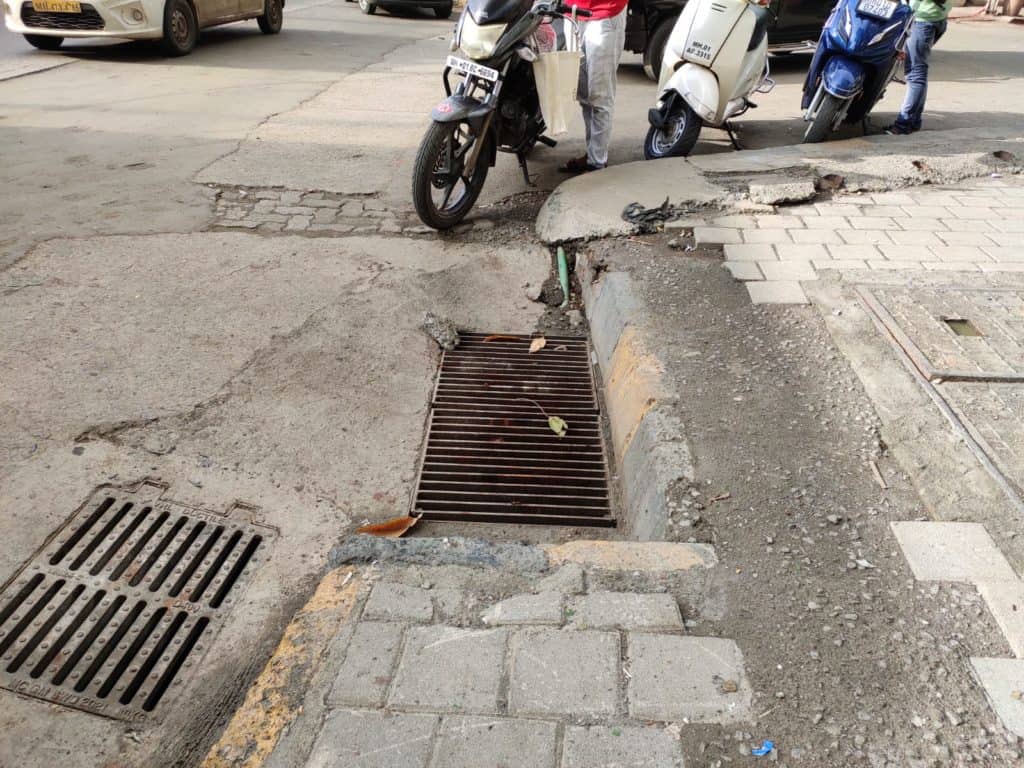Every year as June comes around, Deepak Doshi, owner of a plywood shop at Hindmata junction, starts to prepare for the impact of heavy rains on his shop. “We prepare to save our plywood from getting damaged by storing it at heights and covering it in a tarp, yet every year it does. We are dreading this year’s monsoon season,” he said.
Flooding and waterlogging near the Hindmata bridge is an annual occurrence. A low-lying area with a saucer-shaped topography, the Hindmata junction in Parel is prone to waterlogs and floods. The water level can reach up to four feet and takes much longer to recede as compared to other areas in Mumbai. Over the years, shop owners and residents in the area have tried to cope in different ways. Despite their efforts, the challenges with flooding remain unchanged.
Plight of citizens at the Hindmata junction
From the Parel junction to the Hindmata signal, there are roughly 250-300 shops in the one square kilometre zone. The area consists of saree shops and other hardware like granite, marble, plywood and bathroom fitting shops, all of which are highly susceptible to rainwater damage. “Even on days when rains are moderate, during high tide, water comes up from the drainages. Most waterlogging happens because the drainage system is not built to accommodate the special topographical circumstances,” said Tanveer Sheikh, a worker at a marble shop called Kohitoor.
Lalita Mahar, a safai karamchari in the area has seen the impact of the floods for eight years. Along with six other women, she is responsible for cleaning the roads to avoid clogged drainages in case of heavy rain days. But declogging drainages is not her biggest worry. “Water does not go down the drain, rather it comes up due to inadequate underground holding capacity,” she said.
Shop owners in the area do everything in their capacity to mitigate the impact of the floods. Even then, the shops remain closed for at least 15 days in the monsoons on high rainfall days.
It is not just shops that are affected by heavy rains. The St. Paul Convent School, which is situated in the most saturated flood area under the flyover, cannot remain closed for 15 days. Parents continue to drop their children off at school despite the waterlogging. Teachers and staff in the school volunteer to make pick up and drop off as smooth as possible. “Monsoons are very tough for the school. Along with tending to damaged school property, attendance in school is at an all-time low. For those who do attend, their parents have to walk through dangerous flood waters to drop off their children,” said Sister Martha, a teacher in the school.
Parents need to pack two extra pairs of clothes for the children, and most children change into their uniforms while in school. School buses stop operations and other modes of transport like rickshaws and bicycles can prove to be dangerous.
Read more: Climate change, rainfall patterns and what it means for Mumbai’s monsoon
Mitigation methods of businesses at Hindmata junction
Businesses in the area have raised their shops two feet higher than they used to be. Many shops have even built a stilt area in front of their shops so customers can wait when water levels rise. Many shops invest in plastic barriers that stop water from entering shops or they build permanent wooden or concrete ledges that protect their shops to a certain level. “We spend a lot of money to save our materials, but water still fills up waist high,” said Vijay Dedhia of Lakshmi Saree centre.



Financial losses don’t occur due to damaged materials alone. Needing to remain closed for days at a time leads to major losses, besides, footfall decreases significantly. Daily profit at Lakshmi Saree Centre is Rs 25,000 on average during non-monsoon months, but the monthly profit in July and August is only Rs 60,000-80,000, that too is retained from regular customers and wholesale buyers.
BMC interventions until now
Some structural changes, like raising the levels of roads by up to a foot, and making drains lower have been made, but according to citizens they don’t help the situation much.

IIn 2021, the BMC started projects to resolve the flooding issue at the Hindmata junction. They devised a two-part plan to ease traffic flow on Babasaheb Ambedkar Road. Under the plan, they constructed underground water tanks at the junction below the flyover, and a three-metre-high elevation connecting Hindmata bridge with the Parel TT flyover. While the first will reduce waterlogging, the second will help ease traffic movement.

The project also included constructing underground tanks and pipelines below Pramod Mahajan Udyan in Dadar West and St. Xaviers ground in Parel to store excess rainwater and prevent flooding at Hindmata.
BMC began constructing tanks and laying stormwater drains to channel rainwater to the tanks in July 2021. The construction was completed in October that year when rains had subsided.
The BMC laid a 1,600mm diameter drainpipe, covering a distance of 650m from Hindmata to Pramod Mahajan Park. Officials claimed that once the work is done, the Hindmata area will be relieved of the waterlogging problem.
“Most of this construction was only completed at the end of last year. Monsoons this year will put all these stormwater drains, water pumps and holding tanks to the test,” said Deepak Doshi. According to him, BMC officers visit every year before the monsoons to supervise pre-monsoon works and ask shop owners and workers about other concerns. “But once the flooding happens, we don’t see them making any efforts to speak with shop owners and residents,” he added.
Contrary to this, according to the Assistant Commissioner (AMC) in the F South Ward, 5-7 disaster management ward officers are present on-site at all times to manage the water pumps. “The holding tanks have been built to carry 55 inches of rain per hour and the accumulated water in these holding tanks is released back into the creek at low tide,” said AMC Swapnaja Kshirsagar.
The area under the Hindmata flyover experienced flooding on June 30th when rainfall levels reached 200cm or 78 inches, which is considered to be average for Mumbai.
Despite being a flood-prone area, rent prices in the area are soaring. Shops that are 200 square feet pay up to Rs 60,000 in rent. “For how much we pay in rent and taxes, we shouldn’t have to worry about annual flooding in a city like Mumbai where we have all the technology and quality of labour,” said a shop owner.